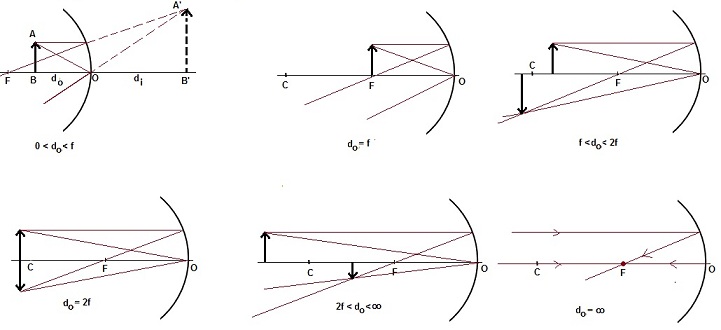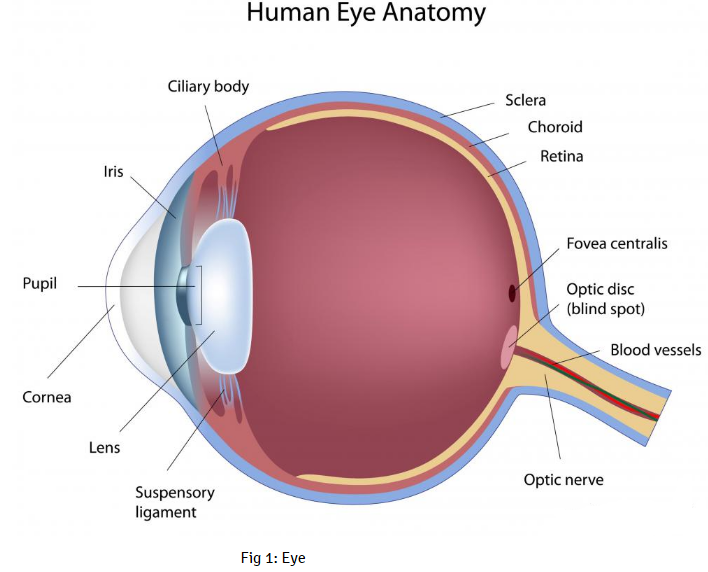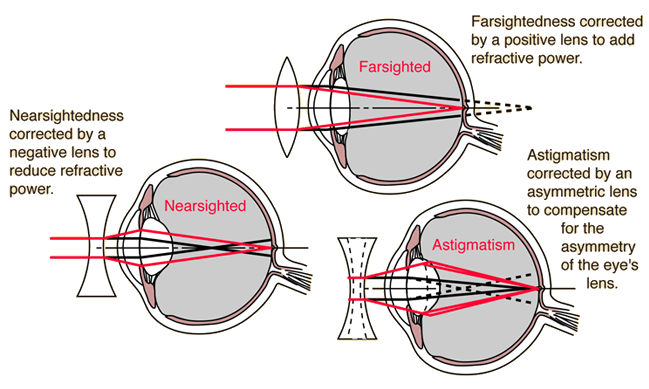-
Chapter 19: LIGHT, SHADOWS, REFLECTIONS
Introduction
Light is made of seven colors. Violet [lowest wavelength] bends most when passing through a prism and red [highest wavelength] least. This phenomenon is called dispersion. It is a transverse wave not a mechanical wave.
Law of reflection says that Angle of incidence is equal to the angle of reflection. Also the angle of incidence, angle of reflection and normal lie on the same plane.
Diffusion is caused when the reflection surface is irregular so reflected rays are not parallel.
Human Eye and its Constituents
The
white part of the eye is tough to protect interior from
accidents.
The
transparent coating is called cornea. Behind the cornea is
the iris, which gives color to the eye.
The
iris has an opening called pupil. Iris controls the
amount of light entering the eye. Behind the pupil
is a convex lens which focuses light on the retina.
The
retina has two cells: rod shaped for dim light and
cone shaped for bright light and colors.
Sensations
of these cells go to the brain via the optic nerve.
Sight Disorders
Sometimes the crystalline lens of eye becomes milky or translucent, this is called cataract.
In myopia, shortsightedness the person can’t see far away objects. This is corrected by using a concave lens.
Hyper metropia or farsightedness is corrected using convex lens.
Presbyopia affects accommodation of eye i.e. ability to adjust its focal length to see objects nearby or far. Such a person uses bi-focal i.e. upper part concave for far sight and lower part convex for near sight.
Astigmatism:
This occurs when the cornea is not spherical in shape. For
example, the cornea could have a larger curvature in the
vertical plane than in the horizontal plane or vice-versa.
If a person with such a defect in eye-lens looks at a wire
mesh or a grid of lines, focusing in either the vertical
or the horizontal plane may not be as sharp as in the
other plane. Astigmatism results in lines in one direction
being well focused while those in a perpendicular
direction may appear distorted. Astigmatism can be
corrected by using a cylindrical lens of desired radius of
curvature with an appropriately directed axis. This defect
can occur along with myopia or hypermetropia.
Mirrors
Image formed by a plane mirror is virtual, erect, laterally inverted.
Spherical mirrors are concave or convex.
Concave
Mirrors
Concave
mirrors are used in dental equipment's, by doctors to
check ear, nose, and throats. Reflectors of torches,
headlights of vehicles, shaving mirrors to get enlarged
image of face.
Image of concave mirrors can be real or virtual, inverted or erect and same size, larger or smaller, depending on position of object with respect to mirror.

Fig 1: Concave mirror
Ref:
N.C.E.R.T Class XI Science
P = center of the reflecting surface. Pole
C= Center of curvature. Lies outside in case of concave, inside in case of convex.
F= Principal focus. Distance between P and F is focal length f.
Convex
Mirror
Convex mirror form image of objects spread over a large area. They are used in rear view or side mirrors of vehicles. Images are virtual, erect and diminished.
Fig 2: Convex Mirror
Ref: N.C.E.R.T Class XI Science
Lenses
Lenses
are transparent. They form images by refraction of light.
Convex
lens
Convex lenses [magnifying glass] are thicker at middle and thinner at edges.
Image
of convex lens can be real or virtual, inverted or erect
and same size, larger or smaller, depending on position of
object with respect to mirror [same as concave mirrors].
Concave
lens
Image of concave lens is always virtual, erect and diminished [same as convex mirror].
Convex lens is used in microscope, refracting telescopes, reflecting telescopes [also have concave lens].
Concave lenses are other way round. Convex lens are converging and concave lenses are diverging. Power of convexlens is positive and concave lens is negative.
Miscelleneous
Refraction of light: Bending of light when it enters a medium is called refraction. Due to refraction pencil appears to bend in water, coin in water appears raised. The object inside water appears enlarged. Twinkling of stars, advanced sunrise or delayed sunset and apparent flattening of sun at sunrise and sunset into oval shape is also caused due to atmospheric refraction.
Dawn and twilight are also due to refraction. they are maximum at the poles and decrease towards the equator.
Total internal reflection occurs when a ray of light traveling from denser to rarer medium is incident at an angle more than the critical angle, it is reflected inside and no refraction takes place.
e.g.: Mirage, diamonds can be cut in such a manner to facilitate total internal reflections to make it shiny, Optical fibers, prisms.
When light ray entered from rarer [optically rarer] to denser [optically denser] medium it bends towards the normal [also speed decreases] and when it enters rarer medium from denser it bends away from the normal [speed increases]. Optical density is different from mass density.
Light travels fastest in vacuum, then air, then liquids and finally solids.
Tydall
effect - Scattering of light causes blue sky
phenomenon and reddening of sun at sunrise and sunset.
Blue wavelength is easily scattered by dust particles,
hence sky appears blue. Violet is scattered more easily
than blue but our eyes are more sensitive to blue color.
However at a great height effect of scattering are
negligible so sky appears dark.
Alert lights are Red as it has higher wavelength and won’t be scattered by dust or fog or smoke.
Similarly at sunrise or sunset, the sunlight travels greater distance to reach us; the smaller wavelengths are already scattered so only longer wavelength i.e. Red reaches us.
Day
birds have more cones than rod cells and in night birds
reverse is the case.
Braille pattern founded in 1821 has 63 characters.
Persistence of vision: Image on the retina persists for one sixteenth of a second after it’s removed. Hence in cinemas the images are flashed at a rate faster than 16 per second.
Objects that give out light are luminous objects.
Shadows need a source of light and an opaque object.
Official YouTube channel of UPSCFEVER - #1
Quiz
Score more than 80% marks and move ahead else stay back and read again!

